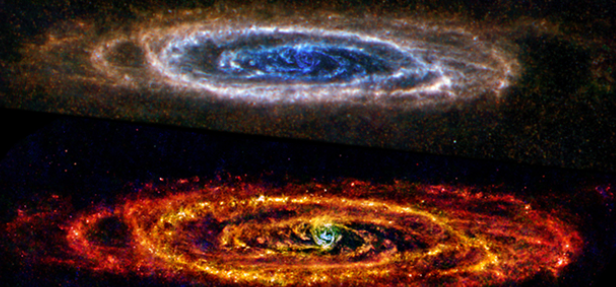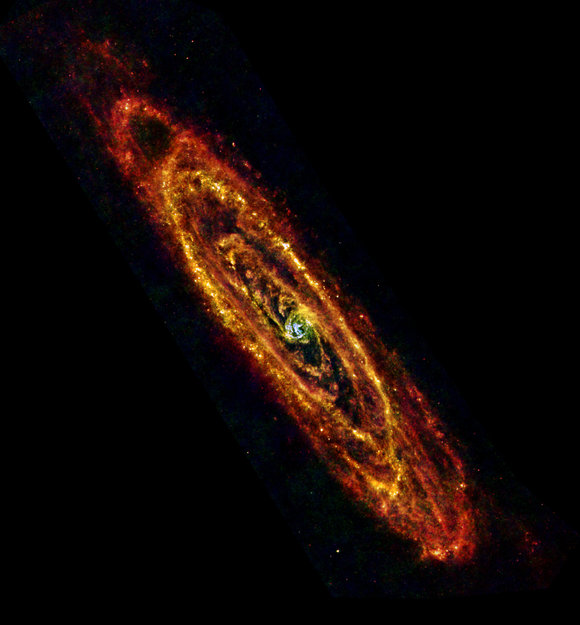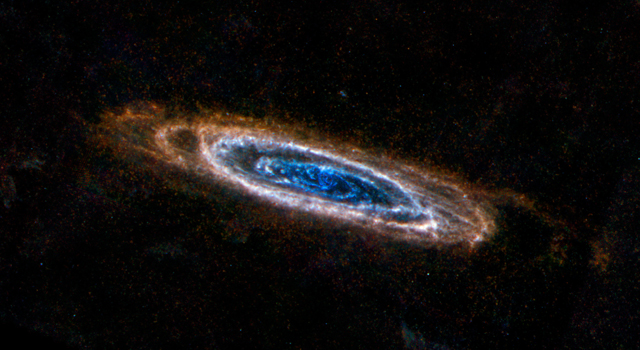It looks like you're using an Ad Blocker.
Please white-list or disable AboveTopSecret.com in your ad-blocking tool.
Thank you.
Some features of ATS will be disabled while you continue to use an ad-blocker.
7
share:
Very nice images ..
Nothing is beautiful as this images of universe ..
Andromeda Galaxy - M31
ESA
28 January 2013
www.esa.int...
photojournal.jpl.nasa.gov...
photojournal.jpl.nasa.gov...



Nothing is beautiful as this images of universe ..
Andromeda Galaxy - M31
ESA
28 January 2013
www.esa.int...
photojournal.jpl.nasa.gov...
photojournal.jpl.nasa.gov...
In this new view of the Andromeda galaxy from ESA’s Herschel space observatory, cool lanes of forming stars are revealed in the finest detail yet. Andromeda, also known as M31, is the nearest major galaxy to our own Milky Way at a distance of 2.5 million light-years, making it an ideal natural laboratory to study star formation and galaxy evolution.
Sensitive to the far-infrared light from cool dust mixed in with gas, Herschel seeks out clouds of gas where stars are born. The new image reveals some of the very coldest dust in the galaxy – only a few tens of degrees above absolute zero – coloured red in this image.



edit on 30-1-2013 by MariaLida because: (no reason given)
Andromeda's coat of many colors
ESA Dec 13, 2012
ESA Dec 13, 2012
ESA's fleet of space telescopes has captured the nearby Andromeda Galaxy, also known as M31, in different wavelengths. Most of these wavelengths are invisible to the eye and each shows a different aspect of the galaxy's nature. Visible light, as seen by optical ground-based telescopes and our eyes, reveals the various stars that shine in the Andromeda Galaxy, yet it is just one small part of the full spectrum of electromagnetic radiation.
There are many different wavelengths that are invisible to us but which are revealed by ESA's orbiting telescopes. Starting at the long wavelength end, the Planck spacecraft collects microwaves. These show up particles of incredibly cold dust, at just a few tens of degrees above absolute zero.
Slightly higher temperature dust is revealed by the shorter, infrared wavelengths observed by the Herschel space telescope. This dust traces locations in the spiral arms of the Andromeda Galaxy where new stars are being born today.
edit on 30-1-2013 by MariaLida because: (no reason
given)
reply to post by MariaLida
These pictures look nice, but why do they look really REALLY fake to me??
Great find either way....
These pictures look nice, but why do they look really REALLY fake to me??
Great find either way....
Nice eye
The pictures give the sense of energy moving outwards due to centrifugal forces.
The pictures give the sense of energy moving outwards due to centrifugal forces.
Andromeda Galaxy is now 2.5 million light-years away also moving toward the Milky Way at about 250,000 miles per hour ..
This two galaxies attract each other and according to scientist and some simulations collision will be in 4 billion years ..
The Andromeda Galaxy is the nearest spiral also biggest galaxy to our Milky Way, but not the closest galaxy overall ..
NASA's Hubble Shows Milky Way is Destined for Head-On Collision
www.nasa.gov...
science.nasa.gov...
This two galaxies attract each other and according to scientist and some simulations collision will be in 4 billion years ..
The Andromeda Galaxy is the nearest spiral also biggest galaxy to our Milky Way, but not the closest galaxy overall ..
NASA's Hubble Shows Milky Way is Destined for Head-On Collision
www.nasa.gov...
science.nasa.gov...
edit on 30-1-2013 by MariaLida because: (no reason given)
Originally posted by Chrisfishenstein
reply to post by MariaLida
These pictures look nice, but why do they look really REALLY fake to me??
Great find either way....
Because they are false-colour images to highlight differences in the temperature of the dust/gas.
Originally posted by PheonixReborn
Originally posted by Chrisfishenstein
reply to post by MariaLida
These pictures look nice, but why do they look really REALLY fake to me??
Great find either way....
Because they are false-colour images to highlight differences in the temperature of the dust/gas.
Exactly.
This is NOT what a person would see if they were "out there" looking at this galaxy. Much of what you see in that image is in the microwave and far-infrared wavelengths -- wavelengths that would be invisible to our eyes. And, as 'PhoenixReborn' pointed out, the colors assigned to those invisible wavelengths in that image are false colors.
This image (below) is what you would see with your eyes if you were "out there" looking at the Andromeda galaxy:
edit on 1/30/2013 by Soylent Green Is People because: (no reason given)
reply to post by Soylent Green Is People
Thanks for that image, I prefer that
It is just as incredible as any filter could make it.
Thanks for that image, I prefer that
It is just as incredible as any filter could make it.
I gasped when I seen the pictures, all of them are equally impressive in my opinion. Absolutly beautiful. Thank you for the pics!!
Originally posted by MariaLida
Andromeda Galaxy is now 2.5 million light-years away also moving toward the Milky Way at about 250,000 miles per hour ..
This two galaxies attract each other and according to scientist and some simulations collision will be in 4 billion years ..
The Andromeda Galaxy is the nearest spiral also biggest galaxy to our Milky Way, but not the closest galaxy overall ..
NASA's Hubble Shows Milky Way is Destined for Head-On Collision
www.nasa.gov...
science.nasa.gov...edit on 30-1-2013 by MariaLida because: (no reason given)
I wonder if the sun will burn out before then, or if we will get to see this whole thing unfold before our eyes.... That is if humanity is still on Earth at that time. I think the sun has about 4-5 billion years of life left in it, according to the video you posted the collision appears to happen around 3.8 billion years from now
What will be our fate (if we're still here)!
Based on current calculations they predict a 50% chance that in a merged galaxy the solar system will be swept out three times farther from the galactic core than it is currently located.[1] They also predict a 12% chance that the Solar System will be ejected from the new galaxy some time during the collision.
Wikipedia
...by the time that the two galaxies collide, the surface of the Earth will have already become far too hot for liquid water to exist, ending all terrestrial life, which is currently estimated to occur in about 1.4 billion years due to gradually increasing luminosity of the Sun
Wikipedia
Well I guess that settles that
new topics
-
Former NYT Reporter Attacks Scientists For Misleading Him Over COVID Lab-Leak Theory
Education and Media: 1 hours ago -
Why did Phizer team with nanobot maker
Medical Issues & Conspiracies: 2 hours ago -
Pro Hamas protesters at Columbia claim hit with chemical spray
World War Three: 2 hours ago -
Elites disapearing
Political Conspiracies: 4 hours ago -
A Personal Cigar UFO/UAP Video footage I have held onto and will release it here and now.
Aliens and UFOs: 4 hours ago -
Go Woke, Go Broke--Forbes Confirms Disney Has Lost Money On Star Wars
Movies: 6 hours ago -
Freddie Mercury
Paranormal Studies: 6 hours ago -
Nirvana - Immigrant Song
Music: 11 hours ago
top topics
-
British TV Presenter Refuses To Use Guest's Preferred Pronouns
Education and Media: 12 hours ago, 16 flags -
Go Woke, Go Broke--Forbes Confirms Disney Has Lost Money On Star Wars
Movies: 6 hours ago, 12 flags -
Pro Hamas protesters at Columbia claim hit with chemical spray
World War Three: 2 hours ago, 9 flags -
Trump To Hold Dinner with President of Poland At Trump Tower Tonight
2024 Elections: 14 hours ago, 8 flags -
Tucker Carlson interviews Christian pastor from Bethlehem.
Middle East Issues: 14 hours ago, 7 flags -
Freddie Mercury
Paranormal Studies: 6 hours ago, 7 flags -
Elites disapearing
Political Conspiracies: 4 hours ago, 7 flags -
A family from Kansas with six children moved to the Moscow region
Other Current Events: 17 hours ago, 6 flags -
A Personal Cigar UFO/UAP Video footage I have held onto and will release it here and now.
Aliens and UFOs: 4 hours ago, 5 flags -
Nirvana - Immigrant Song
Music: 11 hours ago, 4 flags
active topics
-
Israel ufo shoot down drones?
Aliens and UFOs • 25 • : introufo2 -
Pro Hamas protesters at Columbia claim hit with chemical spray
World War Three • 7 • : WannabeeAuCourant -
Why did Phizer team with nanobot maker
Medical Issues & Conspiracies • 3 • : Unknownparadox -
AARO/Dr Kirkpatrick-Caught Lying in UAP report.
Aliens and UFOs • 21 • : introufo2 -
Terrifying Encounters With The Black Eyed Kids
Paranormal Studies • 43 • : TheMichiganSwampBuck -
Elites disapearing
Political Conspiracies • 15 • : opethPA -
-@TH3WH17ERABB17- -Q- ---TIME TO SHOW THE WORLD--- -Part- --44--
Dissecting Disinformation • 513 • : fringeofthefringe -
British TV Presenter Refuses To Use Guest's Preferred Pronouns
Education and Media • 48 • : Therealbeverage -
Former NYT Reporter Attacks Scientists For Misleading Him Over COVID Lab-Leak Theory
Education and Media • 2 • : TheMichiganSwampBuck -
Max Loughan Boy Genius Or Something More?
Science & Technology • 67 • : fluctz
7
